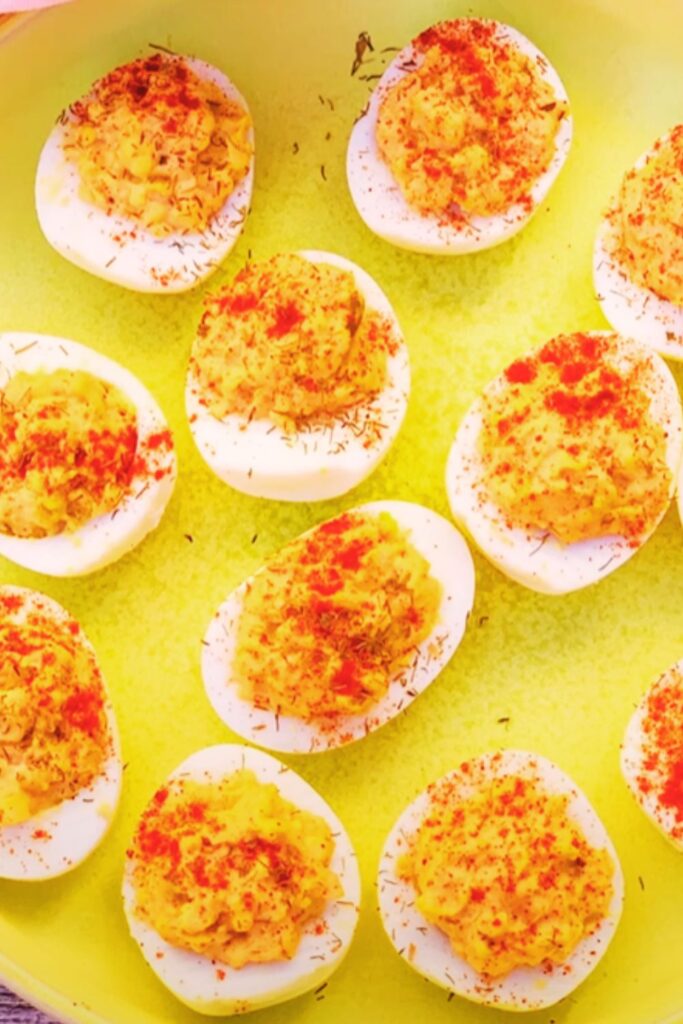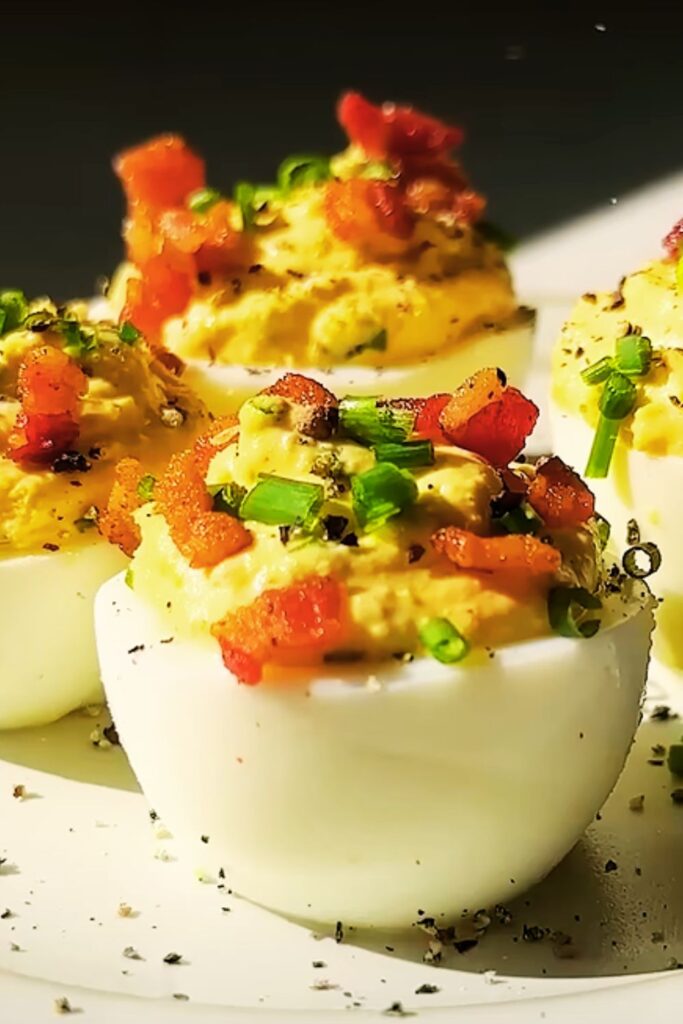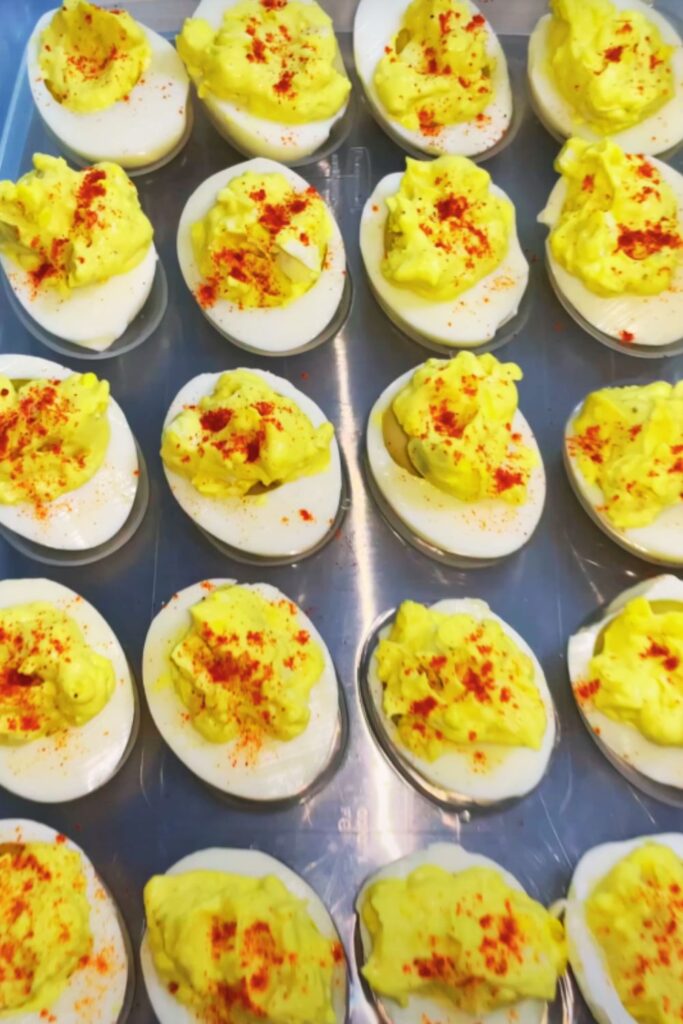There’s something special about walking into a family gathering and spotting that familiar platter of deviled eggs on the table. Growing up in the South, I’ve seen these little culinary gems at every celebration worth mentioning – from Sunday dinners to family reunions, holiday gatherings to church socials. Today, I’m sharing my family’s treasured Southern deviled eggs recipe that’s been passed down through generations, with all the soul and flavor that makes this dish a standout on any table.
A Taste of Southern History
Before diving into the recipe, let me share a bit about why deviled eggs hold such a special place in Southern soul food cuisine. The term “deviled” dates back to the 18th century, referring to dishes made spicy or zesty. But in Black Southern cuisine, our deviled eggs evolved with unique twists that tell a story of resourcefulness, creativity, and cultural heritage.
During times when resources were limited, Black families turned everyday ingredients into something extraordinary. The humble egg – often available from backyard chickens – became a canvas for flavor expression. We didn’t just make deviled eggs; we transformed them with bold seasonings, secret family touches, and presentation styles that turned necessity into art.
What makes these Black folks soul food deviled eggs different? It’s the perfect balance of creaminess with a hint of tang, the touch of sweetness alongside savory notes, and that gentle kiss of heat that keeps you coming back for “just one more.”
The Perfect Hard-Boiled Egg: Where It All Begins
The foundation of exceptional deviled eggs is properly cooked hard-boiled eggs. After countless family cookouts and holiday gatherings, I’ve learned that rushing this step is a recipe for disappointment.
The Foolproof Method:
- Start with eggs at room temperature (leave them out for about 30 minutes before cooking)
- Place eggs in a single layer in a pot
- Cover with cold water about 1 inch above the eggs
- Add 1 tablespoon of white vinegar to the water (helps with peeling)
- Bring to a rolling boil
- Remove from heat, cover, and let stand for exactly 12 minutes
- Transfer immediately to an ice bath to stop cooking
- Let cool completely before peeling
The ice bath step is non-negotiable! It not only stops the cooking process (preventing that unappetizing green ring around the yolk) but also makes peeling significantly easier.

The Classic Black Folks Soul Food Deviled Eggs Recipe
Now let’s get to the heart of the matter—the recipe that has earned me countless requests to “bring those eggs” to every family function.
Ingredients
- 12 large eggs, hard-boiled and peeled
- ½ cup mayonnaise (Duke’s is preferred in many Southern kitchens)
- 2 tablespoons sweet pickle relish
- 1 tablespoon yellow mustard
- 1 teaspoon white vinegar
- ½ teaspoon sugar
- ¼ teaspoon salt
- ¼ teaspoon black pepper
- ⅛ teaspoon paprika, plus more for garnish
- 1 tablespoon finely minced sweet onion
- Optional: dash of hot sauce to taste
For Garnish
- Paprika
- Fresh dill sprigs
- Sweet pickle slices
- Finely chopped chives
Instructions
- Slice the eggs lengthwise and carefully remove the yolks, placing them in a medium bowl.
- Set the white halves on a serving platter or deviled egg tray.
- Mash the yolks with a fork until completely smooth—no lumps! This is critical for that creamy texture.
- Add mayonnaise, relish, mustard, vinegar, sugar, salt, pepper, paprika, and minced onion.
- Mix thoroughly until completely smooth and creamy. Take your time here—the smoothness is what sets great deviled eggs apart.
- Taste and adjust seasonings if needed. This is where I sometimes add a dash of hot sauce if I’m serving folks who appreciate a little extra kick.
- Transfer the filling to a piping bag fitted with a star tip for an elegant presentation, or use a zip-top bag with the corner snipped off.
- Pipe the filling generously into each egg white half, creating a small mound.
- Lightly sprinkle with paprika for that classic finish.
- Refrigerate for at least 1 hour before serving to allow flavors to meld.
Secret Family Variations
What really makes these deviled eggs special are the variations that different families have developed over generations. Here are some authentic additions that you might find in different Black Southern households:
The Creole Touch
- Add 1 teaspoon of Creole seasoning to the filling
- Garnish with tiny slivers of bell pepper
- Incorporate 1 tablespoon finely minced celery for crunch
The Deep South Sweet Version
- Increase sugar to 1 teaspoon
- Add 1 tablespoon finely crushed pineapple (well-drained)
- Use a sweet paprika for garnish
The Savory Soul Version
- Add 1 tablespoon very finely minced smoked ham
- Include ¼ teaspoon garlic powder
- Substitute brown mustard for yellow mustard
- Top with a tiny piece of crispy bacon
The Church Social Special
- Add 2 tablespoons finely shredded sharp cheddar cheese
- Include a dash of Worcestershire sauce
- Top with a small slice of olive or a sliver of pimento
Serving Suggestions
In my family, presentation is almost as important as taste when it comes to deviled eggs. Here’s how to serve them with true Southern hospitality:
- Use a specialized deviled egg platter if you have one (many Southern homes have these as prized possessions)
- Place on a bed of curly parsley or lettuce for an elegant presentation
- Serve well-chilled—never at room temperature
- Pair with other Southern favorites like fried chicken, collard greens, or black-eyed peas
- For a complete soul food gathering, offer alongside macaroni and cheese, cornbread, and sweet tea
For large gatherings, I create a deviled egg bar with the basic eggs and several topping options:
- Crumbled bacon
- Chives
- Pickled okra slices
- Pimento pieces
- Dill sprigs
- Hot sauce bottles
- Extra paprika

Troubleshooting Common Issues
Even experienced cooks occasionally run into challenges with deviled eggs. Here are solutions to common problems:
| Problem | Cause | Solution |
|---|---|---|
| Difficult to peel eggs | Using very fresh eggs | Use eggs that are at least 5-7 days old |
| Green ring around yolk | Overcooking | Follow exact timing and use ice bath immediately |
| Runny filling | Too much mayonnaise or relish | Add more yolk or a sprinkle of instant potato flakes |
| Bland flavor | Insufficient seasoning | Increase mustard and add a pinch more salt |
| Filling not smooth | Inadequate mashing | Use a food processor for perfectly smooth yolks |
| Eggs won’t sit flat | Uneven bottoms | Slice a tiny bit off the bottom to create a flat surface |
| Filling discolors | Exposure to air | Add a bit more acid (vinegar or lemon) and cover tightly |
| Eggs sliding on the plate | Moisture on plate | Pat eggs dry before placing on serving dish |
Make-Ahead Tips for Special Occasions
One of the beauties of deviled eggs is that components can be prepared ahead of time:
- Hard-boil eggs up to 2 days in advance (keep unpeeled in refrigerator)
- Prepare filling up to 24 hours ahead and refrigerate separately
- Assemble completely up to 12 hours before serving
- For best results, pipe filling just before serving
- Always cover prepared eggs with plastic wrap to prevent drying out
Nutritional Benefits of Deviled Eggs
Deviled eggs aren’t just delicious—they’re also quite nutritious. Here’s a breakdown of their benefits:
| Nutrient | Benefit |
|---|---|
| Protein | Each egg half provides approximately 4g of high-quality protein |
| Choline | Essential for brain health and development |
| Vitamin D | One of the few food sources of this important vitamin |
| Lutein & Zeaxanthin | Antioxidants that support eye health |
| Vitamin B12 | Supports energy and nervous system function |
| Healthy Fats | Provides satisfaction and supports nutrient absorption |
Soul Food Wisdom: Tips from the Elders
I’ve gathered some wisdom from the elder cooks in my family that takes these deviled eggs to another level:
- “Always taste as you go, but remember you can add but you can’t take away”
- “The smoothness comes from patience—mash those yolks until your arm gets tired”
- “Never rush the cooling process—that’s what makes them peel like a dream”
- “A little sweet balances the tang—that’s the secret to keeping folks coming back”
- “Presentation matters—we eat with our eyes first”

Frequently Asked Questions
Why are they called ‘deviled’ eggs? The term “deviled” comes from British cooking in the 18th and 19th centuries, where it referred to dishes made with hot or spicy ingredients. The mustard and pepper in traditional deviled eggs gave them this name.
How do I prevent my deviled eggs from getting watery after they sit? Make sure your relish is well-drained, and if your eggs seem watery, a pinch of instant mashed potato flakes mixed into the filling works wonders as a natural thickener.
My grandmother used to add something that made her deviled eggs extra creamy. What might that have been? Many Southern grandmothers added a touch of cream cheese or a dollop of sour cream to their deviled egg filling for extra creaminess.
How many deviled eggs should I prepare per person for a gathering? For a side dish at a potluck or gathering with other foods, plan for 2-3 halves (1-1.5 whole eggs) per person. If they’re being served as an appetizer with few other options, increase to 3-4 halves per person.
Can I make deviled eggs without mayonnaise? Yes! Some Southern families use butter instead, while others opt for Greek yogurt or sour cream as substitutes. Each creates a different flavor profile but can be equally delicious.
Why do some recipes call for steaming eggs rather than boiling them? Steaming can make eggs easier to peel, especially when using very fresh eggs. The gentle cooking also helps prevent overcooking and that dreaded green ring around the yolk.
My eggs always crack during boiling. How can I prevent this? Let eggs come to room temperature before cooking, and start them in cold water that’s brought slowly to a boil. Adding a tablespoon of vinegar to the water also helps prevent cracking.
What’s the best way to transport deviled eggs to an event? Specialized deviled egg carriers are ideal, but if you don’t have one, prepare the egg whites and filling separately, transport in sealed containers, and assemble at your destination.
The Heritage Behind the Recipe
What makes Black folks soul food deviled eggs truly special isn’t just the ingredients—it’s the heritage they represent. These aren’t just appetizers; they’re edible history, representing generations of family gatherings, resourcefulness through challenging times, and the creativity that turned simple ingredients into celebration foods.
When my grandmother made these eggs, she didn’t use measuring spoons. She used her hands, her eyes, and her heart. She’d say, “You have to feel the recipe, not just follow it.” That intuitive cooking style is what gives soul food its name—it feeds more than just the body.
In many Black Southern families, deviled eggs were a way to make something special out of something simple. When elaborate foods weren’t accessible, the humble egg could be transformed into something worthy of celebration. That spirit of transformation—of making something extraordinary from the ordinary—is at the heart of soul food cooking.
Today, when I prepare these eggs for my own family gatherings, I’m not just making food—I’m continuing a tradition. Each perfectly piped yolk represents a link in a chain stretching back generations.
So when you make these deviled eggs, know that you’re not just following a recipe—you’re participating in a living tradition that has brought joy to countless family tables across the South for generations. That’s what makes them truly special.
Q&A with Soul Food Cooking Experts
I reached out to several respected soul food cooks in my community to get their insights on what makes the perfect Southern deviled egg. Here’s what they shared:
What’s the one ingredient that you think makes Black folks soul food deviled eggs different from other versions?
Most agreed that the balance of sweet and savory sets our version apart. Miss Ernestine, who’s been cooking for her church for over 50 years, said, “It’s that touch of sweet pickle relish and the pinch of sugar that makes all the difference. Northern folks often leave that out, but that sweet-savory balance is what makes it soul food.”
Is there a secret technique that improves deviled eggs that most people don’t know about?
Brother James, famous for the deviled eggs he brings to the annual family reunion, shared: “Let your eggs sit in the refrigerator for a week before boiling them. Fresh eggs don’t peel right, and you’ll end up with ugly eggs. Patience makes perfect.”
How have you seen deviled egg recipes change over the generations in your family?
Mother Wilkins, at 92 the oldest cook in our church, noted: “The basics stay the same, but each generation adds their own touch. My grandmother used only mustard and salt. My mother added sweet pickles. I added a touch of onion. My daughter adds a bit of hot sauce. The egg evolves, just like our people do.”
What’s the biggest mistake people make when preparing deviled eggs?
All the cooks agreed: rushing the process. As Aunt Mabel put it, “These eggs ain’t fast food. You can’t rush perfection. From selecting the eggs to letting them cool properly to taking your time with that filling—hurried eggs are never as good as patient eggs.”
In creating these soul food Southern deviled eggs, remember that you’re not just making a dish—you’re continuing a tradition that has brought joy and connection to Black Southern families for generations. Each egg carries with it a history of resilience, creativity, and celebration that makes it so much more than just a delicious appetizer.
So the next time you’re piping that perfectly seasoned filling into those egg white halves, know that you’re participating in a culinary tradition that tells a story as rich and complex as the South itself.



